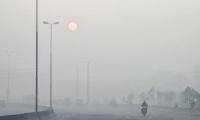KARACHI: Out of the 51 constituents the PMLN is not contesting from, around 30 are from Sindh. According to electoral observers, the PMLN not fielding candidates from these 51 National Assembly constituencies is reflective of the larger issue of the party focusing more on Punjab while ignoring ‘smaller’ provinces.
While it had been assumed that the missing constituencies were due to the PMLN’s seat adjustment agreement with the IPP, on closer inspection the reality is somewhat different. Out of 141 Punjab seats in the National Assembly, the PMLN has seat adjustments on seven with the IPP and has ‘left open’ two seats -- one in Bhakkar and one in DG Khan.
For anyone looking for a reason behind this, journalist Majid Nizami has a simple answer: “Why? Because the PMLN is a Punjab-centric party and at maximum a Punjab-centric party that includes the Hazara Division.” He points to the 1997 elections as an example: “The PMLN had a two-thirds majority after the 1997 elections. At that time, the National Assembly had 207 seats to be contested. The party even then had fielded 176 candidates, leaving 31 seats open.”
In Lahore, the PMLN is not contesting on two seats -- NA-128 and NA-117 -- on which they have made a seat adjustment agreement with the IPP, while from Islamabad they are not contesting from NA-48 and NA-54. There are also some seats they are not contesting from Khushab, Sahiwal, Multan.
But the numbers tell that the majority of the seats the PMLN has left open are from Sindh: around 30-31 constituencies. The remaining are an assortment of seats left from Balochistan (NA-264 and NA-266), and Khyber Pakhtunkhwa (NA-4, NA-19, NA-20, NA-21, NA-22, NA-44, NA-45).
While journalists and political analysts say that this is not entirely an anomaly given that the PMLN has previously also not fielded its candidates from many Sindh constituencies -- as mentioned by Nizami -- they also point to the glaring issue that remains ignored in such electoral calculations: the potency of Punjab’s electoral share.
Is the lopsidedness of Punjab’s large size in the electoral pie making it easier for a party like the PMLN to ignore ‘other’ provinces if it feels it has the required numbers in the ‘biggest’ province as far as electoral power goes?
The PMLN’s Rana Mashhood Ahmad Khan doesn’t think so. When asked by The News about the missing seats in the PMLN’s arsenal as it goes into the polls, the PMLN’s Punjab vice-president says that the seats are mostly from Sindh, some from Balochistan and some from Khyber Pakhtunkhwa. He adds that there are of course also some seats from Punjab where the PMLN has made ‘seat adjustments’ with the IPP as well as those seats where the PMLN was going to make a seat adjustment with the PML-Q but did not end up doing. In the constituencies where the PMLN and PML-Q failed to form a seat adjustment alliance, Mashhood says by the time that happened the party ticket nomination process was over so “now the PMLN has its candidates on those seats but they are not using the ‘sher’ symbol”.
For journalist Hassan Iftikhar, it is quite clear that in areas where the PMLN knows it has no vote bank, it doesn’t even try there. But he too highlights that if a party sweeps Punjab, it doesn’t even need that many seats from the other provinces to make government. Essentially, says Iftikhar, “this [leaving 51 constituencies open] is something that should not have happened. The PMLN is not even organised enough to launch candidates in all of the constituencies. Because it is a private limited company and not a political party, its organisation reflects that.”
When asked about this, Mashhood says that the PMLN has been getting seats all over Pakistan in the past. He too brings up the 1997 elections as an example, citing how the party got a two-thirds majority. There is a reason behind the current lapse, per Mashhood: “Please keep in mind that in 2018, thousands of our workers were arrested, and our party was made to have a mini-collapse. Despite the challenges and the very little time we had to work on these issues, we have managed to field such a large number of candidates.”
The PMLN leader also adds that even if the party in the past didn’t get seats from Sindh or Balochistan or KP “it’s not like we didn’t get work done in those areas regardless”. Not everyone agrees with this assessment of the PMLN’s efforts, however. Political observers feel that in the PMLN’s calculations, the party would rather spend their energies in areas where they know they have a chance at a win. And this is not just limited to electoral politics. Iftikhar says the PMLN also looks at development in much the same fashion: “The party also does development work in only these areas [where they get elected from or have a chance at being elected from].”
With Nawaz Sharif and the PMLN seeing only the Hazara Division in KP as an electoral likelihood for the party, their strategy regarding Sindh has a similar practical outlook. The assumption is that when it comes to Sindh, it is almost impossible to dislodge the PPP from there. This seems to be the PMLN’s thinking as well. There is also the PTI factor when it comes to Karachi.
Iftikhar adds another factor, asking: “What is the PMLN selling to the [Karachi] voters? The PTI has its ‘tabdeeli’ dream to sell -- whether real or not -- but the PMLN doesn’t even have a dream to sell. These are 1980s politicians who have been stretching their politics for a very long time. They have the one ‘development’ model of Punjab to sell. But for that, they would have to offer Shehbaz Sharif.”
The PMLN on its part says it is looking to strengthen its party presence in all the provinces post-election, Mashhood adding that in Sindh “it must be remembered that we have seat adjustments with the MQM, GDA, JUI-F and others.”
But cynical calculations seem to trump any lofty ideals in electoral politics. Iftikhar points out that, with the ECP’s rule that at least five per cent women have to be nominated in general seats, the PMLN “has given the majority of its women’s seats from Sindh -- around 9-10. A party is required to give a total of 13 general seats to women.” In this way, the party has not only fulfilled a requirement but also done so in a way that ensures its ‘sure-shot’ seats are not affected.
Eventually, parties like the PPP and PMLN seem to have figured out that a smarter play is to not focus on the number of seats they are contesting from but on the success rate. In this, Nizami offers the example of the Jamaat-e-Islami, which fields candidates in almost all constituencies but it’s not like the party wins those seats. He adds: “for these parties [PPP and PMLN], it’s not the number of tickets but the number of wins.”
Kidney-related diseases rank as the 12th leading cause of death in Pakistan
Officials say section 144 of CrPC is imposed on a request from the additional inspector general due to security concerns
Neither PPP joined federal government nor any expansion was made, hence several ministries deprived of ministers
Air quality index of Karachi surpasses 300 during winter
If government wants meaningful results it should reduce electricity rates under the winter package
"We appreciate Spain’s support in achieving GSP Plus status and highly value our friendly ties," says Punjab CM







